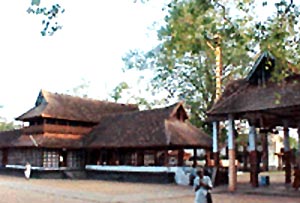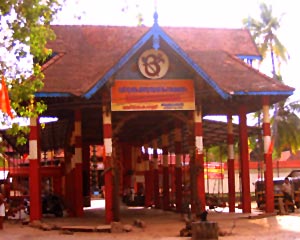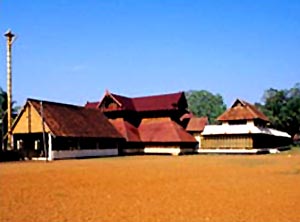 Often referred to as the Venice of the East because of nature`s bounty Alappuzha houses a decent number of religious sites. Some of these temples are located amidst the backwaters while the others are famous for their architecture and antiquity.
Often referred to as the Venice of the East because of nature`s bounty Alappuzha houses a decent number of religious sites. Some of these temples are located amidst the backwaters while the others are famous for their architecture and antiquity.
Mullakkal Rajarajeshwari Temple: The Devi shrine is situated at the heart of this commercial centre, known for beautiful backwaters. The festivals of Navaratri (Sept-Oct) and Thaipuyakavadi (Jan-Feb) are celebrated here with lot of pomp.
Ambalapuzha: Once Bilvamangalam Swami and king Pooradam Thirunal of Champakasseri were sailing in a boat. They heard the melodious strains of a flute coming from an Ashwatha tree. The Swami knew that it was the music of Lord Balagopala (venu ganam), and they decided to build a temple at the spot.
At the time of consecration, a defect was found on the idol and the king and the devotees were greatly disappointed. Following the Swami`s advice, they brought an idol of Parthasarathi from Kuruchi village secretly and consecrated it at the new shrine. This event, which took place in 1613 AD, is commemorated as a boat race during Onam. The Lord is worshipped as Unnikrishna. He is seen holding a whip in the right hand and Shanku in the left hand.
Paal Paayasam (milk porridge), the noon Neivedyam for the Lord, is very popular among devotees.
The 10 days festival during March-April is attended by pilgrims with lot of enthusiasm. On the ninth day, the Natakasala sadhya (feast) is conducted in honour of traditional percussion instrument artistes.
 Haripad: Parasurama had installed Lord Subramanya in this shrine. The idol is known to have been later obtained from a river. The Pratishta ceremony is celebrated as Payipad Boat Race.
Haripad: Parasurama had installed Lord Subramanya in this shrine. The idol is known to have been later obtained from a river. The Pratishta ceremony is celebrated as Payipad Boat Race.
Mannarsala: Snake worship has been popular in Kerala from time immemorial. Many houses have small shrines dedicated to the serpent God, known as Sarpakavu. The temple in Mannarsala, situated in a grove, enshrines Nagaraja and His consort Nagalakshmi or Sarpayakshi. Thousands of stone Naga images are found in the grove.
Uruli Kamizhthal is a unique worship performed by childless couples. When blessed with a child, they visit the temple again and put the vessel back in its right position. Monthly Shivaratri and Ayilyam (Aslesha) star days are auspicious.
Chengannur Bhagavathi Temple: Chengannur is situated on the banks of river Pampa. Though the temple here is dedicated to Shiva and Parvati, it is better known as Bhagavathi shrine. Legends say that sage Agastya had his ashram on the hillside here. Shiva and Parvati, after their marriage at Mount Kailash, came to visit the sage, who could not attend the divine wedding.
 Aaraattu and Thiruputtu festival take place. During these ceremonies the image is taken in a procession to river Pampa for the ritual. The devotees consider it auspicious to witness this event.
Aaraattu and Thiruputtu festival take place. During these ceremonies the image is taken in a procession to river Pampa for the ritual. The devotees consider it auspicious to witness this event.
Chengannur is also revered as one of the 51 Shakti Peetas, where a part of Sati`s body fell after the Daksha Yaga.
Aranmula: Lord Krishna is depicted as Parthasarathi, the divine charioteer, holding His Sudarsana Chakra. He is seen in a rare mood as he was in the Kurukshetra battle. The image was installed by Arjuna at Nilakkal on the banks of Pampa when the Pandavas were on a pilgrimage. The image was later shifted to this place in a shaft made of six bamboos. Hence the name Aranmula (Aru means six and mula means bamboo).
The temple is considered one of the sacred 108 Tirupatis. It is also one of the five famous Krishna shrines of Kerala, the other four being Guruvayur, Trichambaram, Thiruvarpu and Ambalapuzha.
Aranmula boat race is held in honour of the installation of Lord Parthasarathi on the last day of Onam celebrations (Aug-Sept), known as Uthirattathi.
Vallasadya feast is held during Onam festivities with Vallomkali boat race. This commemorates an incident in which the Lord appeared before a pious Namboodri as an Athithi. A boatful of foodstuff (Thiruvona Chelavu Thoni) is still carried from nearby Kattoor village to Aranmula on this occasion.
Thiruvalla: Sri Vallabha (Vishnu) temple is situated 3 km from the station. A 50 foot tall granite flag staff with a Garuda image on top of it adorns the temple.











